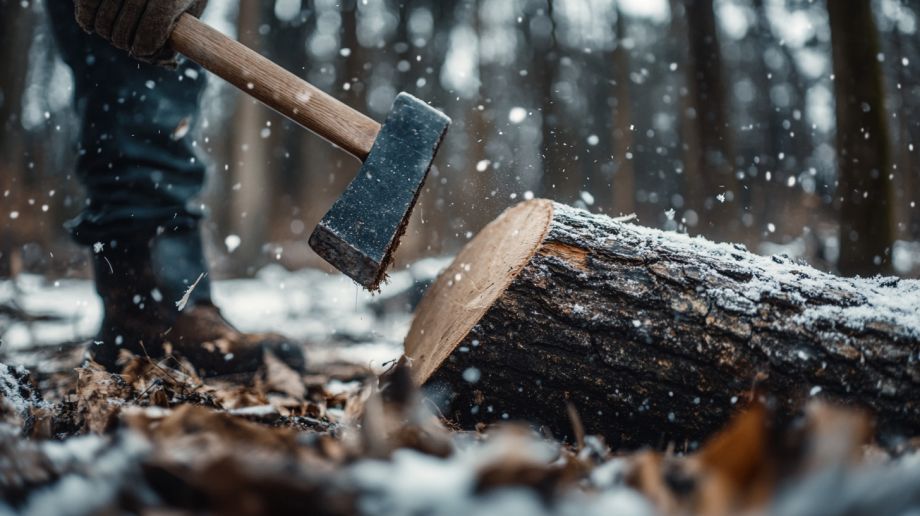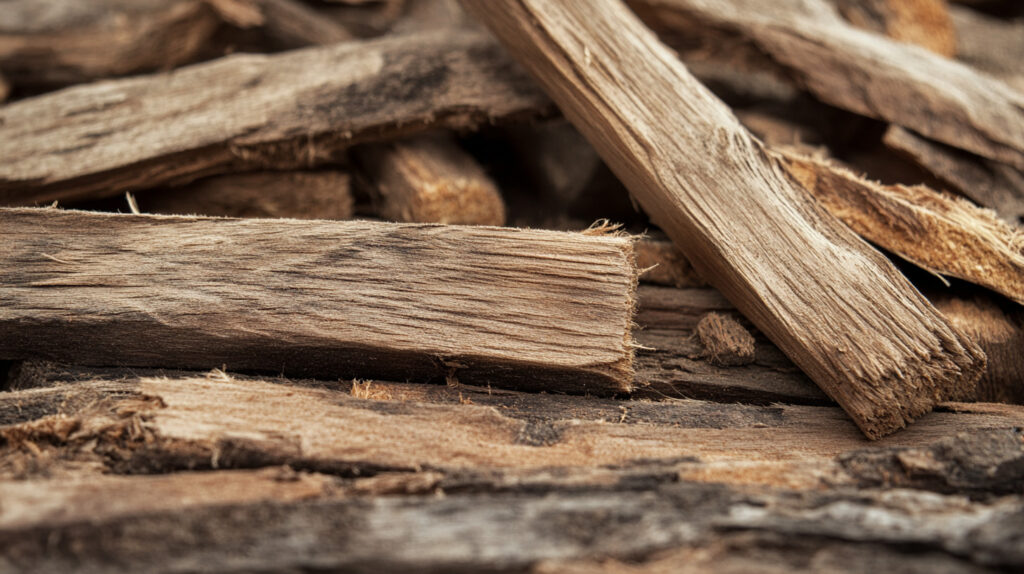
The 8 Toughest Wood To Split
Ever wonder what the toughest wood to split is?
Maybe you’ve been out there with an ax, working up a sweat and getting nowhere. Or you’ve watched someone else struggle and thought, “What’s the big deal?”
Well, turns out some trees are just built to resist.
In this post, I’ll go over the eight toughest woods to split, and explain why they’re difficult and what makes them stand out.
#1 Elm

Elm tops our list of the toughest wood to split.
Its wood fibers are like a tightly woven mat, making it a real challenge to get through.
When you try to split elm, you’ll notice that it tends to absorb the impact, and your ax might just bounce right off! The fibers stretch and compress rather than separate.
Also Read: Can You Cut Off The Top Of A Holly Tree?
Fresh-cut elm is the most difficult. You need to let elm season for a good long while (at least an year) before you even think about splitting it.
Some people might even wait until the bark starts falling off on its own.
If you’ve got access to a hydraulic splitter, that’s your best bet for elm. If you’re going old school with tools, try splitting on the coldest day you can stand to be outside.
Despite all the trouble, elm burns hot and long, so it’s worth the effort if you can manage it.
#2 Sweet Gum
Sweet gum is another wood that’ll test your patience.
It’s got this interlocked grain that just doesn’t want to come apart. Instead of nice clean splits, you often end up with a stringy mess.
Another annoying thing about sweet gum is that it likes to grab onto your splitting tools. You might find yourself spending as much time trying to free your stuck ax as you do actually splitting.
On the bright side, sweet gum dries out pretty quickly compared to some other woods. It also smells nice when you burn it.
But it doesn’t give off as much heat as some other hardwoods, so you’ll have to decide if it’s worth the trouble.
#3 Ironwood/Hornbeam
Ironwood, also known as hornbeam or musclewood, really lives up to its name.
This wood is incredibly dense and hard, making it a real challenge to split, even for people who’ve been doing it for years.
It’s so dense that your splitting tools might just bounce off or get stuck. The grain of ironwood is often twisted or irregular, which makes it even harder.
Even though it’s a pain to split, ironwood makes excellent firewood once you get it processed.
It burns really hot and for a long time, so people who can manage to split it really value it. It actually puts out about as much heat as hickory, which is considered one of the best firewoods.
If you want to split it by hand, you’ll want to use a heavy maul rather than an ax.
Also, check out our stump grinding and tree removal services.
#4 Sycamore
Sycamore trees are beautiful to look at, but when it comes to splitting them, they’re not so pretty.
The main issue with sycamore is the way its wood grain grows. Instead of nice straight lines, the fibers interlock with each other, making it tough to get a clean split.
When you try to split sycamore, especially if it’s freshly cut, you might feel like you’re trying to chop a rubber tire.
The wood tends to tear instead of split, leaving you with jagged, uneven pieces.
Sycamore is also known for being pretty wet when it’s first cut. All that extra moisture makes it even harder to split.
#5 Black Gum
Black gum, also called tupelo, is another wood that’ll give you a run for your money. Its interlocked grain makes it resist splitting, and tools often get stuck in it.
Like sweet gum, it tends to tear instead of split cleanly, which can be pretty frustrating.
Fresh-cut black gum is especially tricky because it’s often full of moisture.
This wetness, combined with its structure, can make splitting it by hand a real challenge.
Despite all the trouble it gives you while splitting, black gum does make pretty good firewood once you get it processed and properly dried.
It burns at a moderate heat and lasts a decent amount of time. Some people even like the sweet smell it gives off when it’s burning.
#6 Cottonwood
Cottonwood might not be as hard as some other woods, but it’s still tough.
The biggest issue with cottonwood is that it’s stringy. When you try to split it, instead of breaking cleanly, it tears into long strips that don’t want to separate completely.
Cottonwood is also known for having lots of knots and irregular grain patterns, especially in the branches and upper parts of the tree.
These quirks can make splitting even more of a challenge.
Plus, it doesn’t give off as much heat when burned, so you might wonder if it’s worth the effort.
Cottonwood has a relatively low BTU (British Thermal Unit) rating compared to many other firewood types, meaning you need to burn more of it to produce the same amount of heat.
If you’re splitting it by hand, try to split the wood when it’s as fresh as possible.
Oddly enough, it can actually get harder to split as it dries out and the fibers toughen up.
#7 Beech
Next up on our list is Beech.
When it’s freshly cut, it can be a real pain to split. The wood fibers are packed tightly together and your tools bounce off or get stuck.
Beech is also pretty dense, which adds to the challenge.
Just like the others, it gets easier to split as it dries out. If you let beech rounds sit for 6-12 months, you’ll often find the job much easier.
As the wood dries, small cracks form that give you natural splitting points.
Once you get it split and seasoned, beech is great firewood. It burns hot and long, and it’s especially good for keeping your fire going overnight in a wood stove.
It also doesn’t produce much smoke when it’s properly dried.
#8 Maple

The last toughest wood to split on our list is maple.
I know I know, not all maple wood is tough to split, but some types can be a real pain to deal with, especially the ones with twisted grain. Like sugar maple, for example.
It’s really dense and often has this irregular grain that makes it super unpredictable to split.
Now, if you’ve got straight-grained maple, it’s usually pretty easy to split.
But if you come across pieces with knots, burls, or twisted grain, it’s a whole different story. These bits can make it really hard to split along the usual lines, and require a lot more effort.






